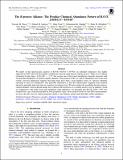Notice
This is not the latest version of this item. The latest version can be found at:https://dspace.mit.edu/handle/1721.1/132436.2
The R-process Alliance: The Peculiar Chemical Abundance Pattern of RAVE J183013.5-455510
| dc.contributor.author | Placco, VM | |
| dc.contributor.author | Santucci, RM | |
| dc.contributor.author | Yuan, Z | |
| dc.contributor.author | Mardini, MK | |
| dc.contributor.author | Holmbeck, EM | |
| dc.contributor.author | Wang, X | |
| dc.contributor.author | Surman, R | |
| dc.contributor.author | Hansen, TT | |
| dc.contributor.author | Roederer, IU | |
| dc.contributor.author | Beers, TC | |
| dc.contributor.author | Choplin, A | |
| dc.contributor.author | Ji, AP | |
| dc.contributor.author | Ezzeddine, R | |
| dc.contributor.author | Frebel, A | |
| dc.contributor.author | Sakari, CM | |
| dc.contributor.author | Whitten, DD | |
| dc.contributor.author | Zepeda, J | |
| dc.date.accessioned | 2021-09-20T18:22:22Z | |
| dc.date.available | 2021-09-20T18:22:22Z | |
| dc.identifier.uri | https://hdl.handle.net/1721.1/132436 | |
| dc.description.abstract | © 2020. The American Astronomical Society. All rights reserved. We report on the spectroscopic analysis of RAVE J183013.5-455510, an extremely metal-poor star, highly enhanced in CNO, and with discernible contributions from the rapid neutron-capture process. There is no evidence of binarity for this object. At =-3.57, this star has one of the lowest metallicities currently observed, with 18 measured abundances of neutron-capture elements. The presence of Ba, La, and Ce abundances above the solar system r-process predictions suggests that there must have been a non-standard source of r-process elements operating at such low metallicities. One plausible explanation is that this enhancement originates from material ejected at unusually high velocities in a neutron star merger event. We also explore the possibility that the neutron-capture elements were produced during the evolution and explosion of a rotating massive star. In addition, based on comparisons with yields from zero-metallicity faint supernova, we speculate that RAVE J1830-4555 was formed from a gas cloud pre-enriched by both progenitor types. From analysis based on Gaia DR2 measurements, we show that this star has orbital properties similar to the Galactic metal-weak thick-disk stellar population. | en_US |
| dc.language.iso | en | |
| dc.publisher | American Astronomical Society | en_US |
| dc.relation.isversionof | 10.3847/1538-4357/ab99c6 | en_US |
| dc.rights | Article is made available in accordance with the publisher's policy and may be subject to US copyright law. Please refer to the publisher's site for terms of use. | en_US |
| dc.source | The American Astronomical Society | en_US |
| dc.title | The R-process Alliance: The Peculiar Chemical Abundance Pattern of RAVE J183013.5-455510 | en_US |
| dc.type | Article | en_US |
| dc.relation.journal | Astrophysical Journal | en_US |
| dc.eprint.version | Final published version | en_US |
| dc.type.uri | http://purl.org/eprint/type/JournalArticle | en_US |
| eprint.status | http://purl.org/eprint/status/PeerReviewed | en_US |
| dc.date.updated | 2020-10-23T15:59:05Z | |
| dspace.orderedauthors | Placco, VM; Santucci, RM; Yuan, Z; Mardini, MK; Holmbeck, EM; Wang, X; Surman, R; Hansen, TT; Roederer, IU; Beers, TC; Choplin, A; Ji, AP; Ezzeddine, R; Frebel, A; Sakari, CM; Whitten, DD; Zepeda, J | en_US |
| dspace.date.submission | 2020-10-23T15:59:15Z | |
| mit.journal.volume | 897 | en_US |
| mit.journal.issue | 1 | en_US |
| mit.license | PUBLISHER_POLICY | |
| mit.metadata.status | Authority Work and Publication Information Needed |
